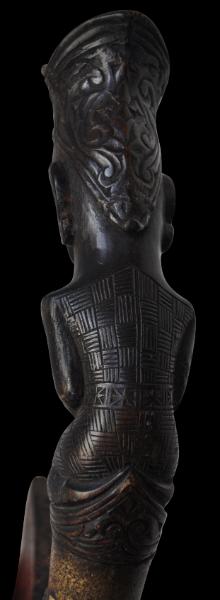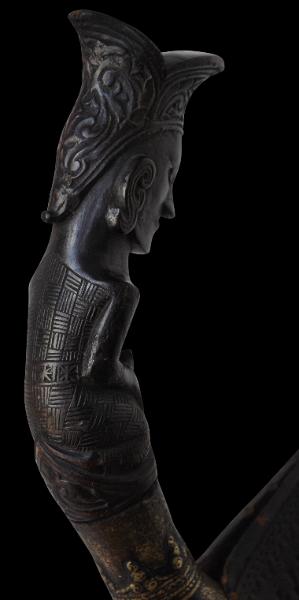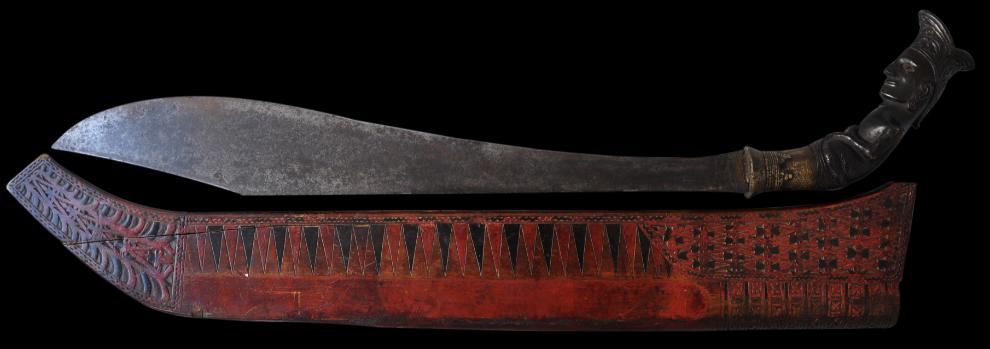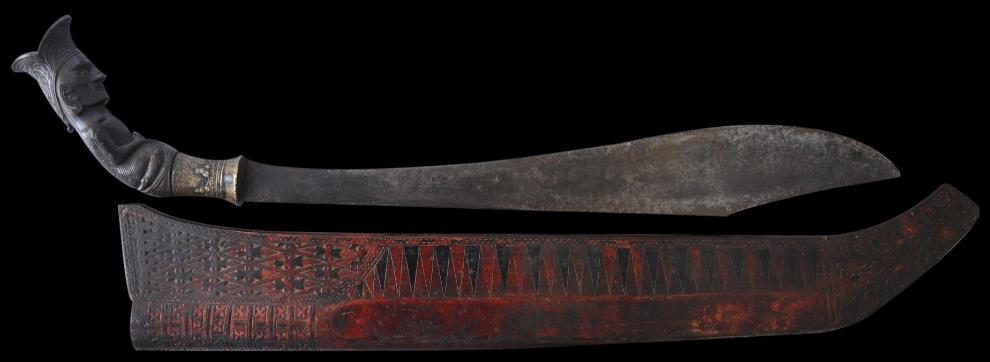Batak Piso Sword
Magnificent Carved Horn & Wood Piso Sanalenggam Sword
Pakpak Batak People, North Sumatra, Indonesia
19th century
length: 64cm
Piso sanalenggam
swords are important heirloom (pusaka) items among the Batak people of north Sumatra. They were made for datu priests from the Pakpak/Dairi region and used in conjunction with the preparation of medicine and magical substances, according to Sibeth & Carpenter (2007, p. 234).
The example here is the best example of a Batak
piso sanalenggam sword that we have seen and seems superior to published examples. The hilt is large and superbly rendered. The scabbard is wonderfully patterned and coloured. And the overall patina is rich and deep with a honeyed-red hue. This is a museum-quality piece by any measure.
The hilt, of buffalo horn, is in the form of a delicately carved kneeling stately male ancestor figure. The figure is bent forwards with his eyes downcast. His face is particularly naturalistically rendered. His hands are arranged with the fingers pointing downwards but with the thumbs pointing up, a position often found in Batak sculpture (Sibeth & Carpenter, 2007, p. 248).
The figure’s headdress or crown is carved with swirling leafy motifs. It flares at the top and curls up at the back of the neck. The waist cloth is carved to suggest that it stretches tightly across the figure’s body and is carved with a cross-hatched checkered pattern. The hilt is particularly finely; indeed we have been unable to find an example of an ancestor hilt with finer carving.
Representations of ancestors have protective, talismanic value in many tribal societies. The image of the ancestor on the handle of this sword is meant to enhance its strength (Jay, 2007, p. 47).
The lower part of the hilt has a brass sleeve that has been cast with bamboo shoot motifs, and which flares where the hilt meets the scabbard.
The scabbard is flat and broad, and has a low rib that runs the entire length on both sides. The mouth of the scabbard broadens, and the end of the scabbard curves towards the blade’s edge.
The scabbard is notable for its complex, etched and coloured decoration. It has triangular motifs on both sides for much of its length. These alternate between red and black colouring in a particularly striking schema. The end of the scabbard has a vegetal motif, and the mouth is decorated with a red and black woven pattern.
The red pigment used to colour such scabbards was obtained from red earth (
batu hula) which was pounded fine with lime and mixed with resin as a binding medium. Some sources suggest that the blood of killed enemies also was added to this mixture. Black was obtained from charcoal which was similarly mixed (Sibeth, 1991).
The blade is plain, broad, and the edge gently undulates.
Examples of
piso sanalenggam swords have been published in ter Keurs (2008, p. 88), Van Zonneveld (2001, p. 109), Sibeth (2000. p. 61), and Sibeth (1991, p. 163.)
The Batak are an ethnic group whose ancestral land is in northern Sumatra. In the past, they practiced ritual cannibalism. Today they number around four million and form one of Indonesia’s larger ethnic minorities. The spectacular volcanic Lake Toba (
Danau Toba) in north Sumatra is the ancestral home to the largest Batak group, the Toba Batak. The lake is the largest freshwater lake in Indonesia.
The sword is in fine condition. As can be expected, the scabbard has some age-related shrinkage cracks and minor flaking. The hilt is free of any chips or losses. There is no restoration. The sword is accompanied by a custom-made metallic stand.
References
Jay, S., Art of the Ancestors – Nias, Batak, Dayak: From the Private Collections of Mark A. Gordon & Pierre Mondolini, Alliance Francaise, 2007.
Sibeth, A.,
The Batak: Peoples of Island Sumatra, Thames & Hudson, 1991.
Sibeth, A.,
Batak: Kunst aus Sumatra, Museum fur Volkerkunde, 2000.
Sibeth, A., & B. Carpenter,
Batak Sculpture, Editions Didier Millet, 2007.
ter Keurs, P.
et al, Au Nord de Sumatra, Les Batak, Musee du Quai Branly/5 Continents, 2008.
Van Zonneveld, A.,
Traditional Weapons of the Indonesian Archipelago, C. Zwartenkot Art Books, 2001.
Provenance
European art market
Inventory no.: 1849
SOLD
An early photograph of some Batak villages.

















